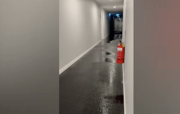Wood heater pollution is a silent killer. Here's where the smoke is worst
By
ABC News
- Replies 0
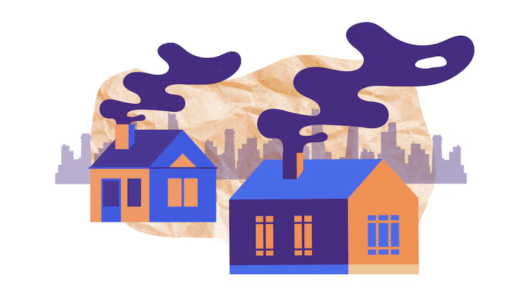
A small minority of houses burn wood for heat, but their smoke is breathed by millions. Image source: ABC News.
Every year the winter cold brings an ambient haze of wood heater smoke to the suburbs, streets and houses of southern Australia.
This smoke can aggravate asthma, divide neighbours and drive people inside.
Now, new modelling gives a clearer picture of its toll on the nation's health.
The Centre for Safe Air at the University of Tasmania estimates long-term exposure to wood-heater smoke causes 729 premature deaths every year in Australia, which is more than the deaths attributable to emissions from the national fleet of 20 million vehicles, or from energy generation, or even bushfires.
Along with this figure, the Centre has built the first national map of wood-heater emissions and deaths attributable to these emissions, with a resolution that can pick out clusters of suburbs most at risk.
Cost-of-living pressures, power price hikes and a wood-heater sales boom during COVID may mean more houses are burning wood than ever before.
Meanwhile, Australians are increasingly aware the smoke is a risk to their health.
Neighbourly bust-ups over the issue appear to be on the rise.
Here's where the smoke is worst, and where long-term exposure costs the most lives.
A national map of wood heater pollution
The Centre for Safe Air combined particulate pollution readings from around Australia with surveys of wood heater use to generate its national map of wood heater pollution.Let's focus on the cities in the south-east corner of Australia, which has the highest concentration of wood heaters.
As you might expect, the wood smoke is generally thickest in regional areas.
Towns like Armidale in NSW or Devonport in Tasmania have well-documented smoke problems.
"In small communities where every second person has a wood heater, you do get that pall of smoke and it's really dense," said Fay Johnston, lead investigator at the centre.
But wood heater smoke is not solely a regional issue.
In fact, when we look at its public health impact, or how wood smoke affects the population as a whole, we find wood smoke causes more harm in capital cities than in regional areas.
How does wood smoke affect health?
Every morning, Lisa checks her neighbour's chimney for white smoke.The young mother, who asked to remain anonymous, realised there was a wood-smoke problem soon after moving with her family to Sydney's Sutherland Shire.
"[The neighbour] runs the wood heater most weekday evenings and throughout the weekend, so we can't open our windows, can't access our backyard," she said.
"Our other neighbour says their cat smells of smoke."
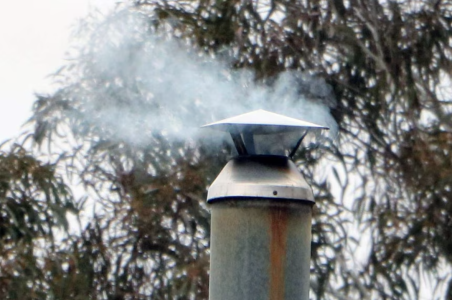
White smoke can indicate the use of wet wood or other issues, like insufficient air for combustion. Image source: ABC Radio / Clarissa Thorpe.
She said she was forced to keep her toddler inside on bad smoke days, worried about his health.
When she politely raised the issue with the wood-burning neighbours, she said they responded defensively: "They said 'We've been doing this for 20 years and no-one else has complained.'"
Wood smoke contains tiny airborne particles that can be trapped in our lungs. Long-term exposure can cause heart and lung disease.
Short-term exposure can aggravate asthma or worsen pre-existing heart conditions.
Even a low background exposure to wood smoke can have a measurable public health impact.
Wood smoke a killer in biggest cities
Wood heaters are so polluting, it only takes a relatively small number of homes burning wood to expose millions of people in a city to pollution, said Professor Johnston from the Centre for Safe Air."You don't necessarily see or smell a thick blanket of smoke, but the fact it's increasing the background pollution every winter means we can measure the effect on the health of the population."
By combining this measured effect of wood smoke on health with the estimate of wood heater emissions in different parts of the country, the centre created a second national map, showing the public health impact of wood smoke.
The map below shows estimated earlier-than-expected deaths per 100,000 people due to exposure to wood-heater smoke. The top regions are in south-east Australia.
The public health impact of wood smoke squarely falls hardest on the relatively heavily populated cities, even though the concentration of wood smoke may be lower than in some regional towns.
And there's one city where the public health impact is greatest.
Perhaps surprisingly, given their cooler climates, it is not Hobart or Melbourne.
Which city has the most deaths from wood smoke?
A higher proportion of people die earlier in Lisa's home city of Sydney than expected due to wood-heater pollution than other parts of south-east Australia.This is partly due to its topography, with the harbour and surrounding land forming a bowl that traps smoke.
"Our topography definitely lends itself to trapping air pollutants within the Sydney basin," said Peter Irga, an expert in air quality at the University of Technology Sydney.
"Other than Launceston, the other major cities don't have that basin topography."
Within this bowl, "middle suburbs" such as Parramatta or Marrickville have a combination of high population density, freestanding homes with chimneys, and access to relatively cheap firewood.
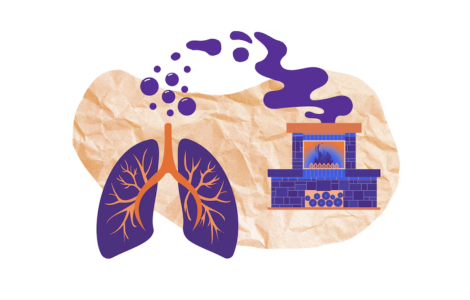
Recent research suggests there is no safe level of exposure to microscopic particulate pollution known as PM2.5. Image source: ABC News.
About 5 per cent of homes in Sydney own a wood heater, but the Centre for Safe Air's modelling suggests these relatively few emitters cause more than 300 earlier-than-expected deaths in the city every year.
"The modelled estimate of deaths attributable to wood heater particulate pollution are higher than those attributable to motor vehicle particulate pollution," Professor Johnston said.
"Wood heaters really punch above their weight when it comes to putting pollution into the atmosphere, relative to the benefit they give us in terms of heat.
"We pay a big price in air quality for that heat."
But these maps don't tell the full story.
The modelling relies on air-quality measurement stations dotted around the country that don't capture the emissions for those directly downwind of wood heater chimneys.
It's here, at the very local scale, that smoke can be thickest.
And where there's smoke, there's often angry neighbours.
Neighbours clash over smoke pollution
Arabella Daniel, a Melbourne-based community organiser against wood heater pollution, said it was "a neighbour against neighbour issue".Ms Daniel, who once took legal action against a neighbour over wood smoke, runs the My Air Quality Australia Facebook page, which has 3,000 members.
"We've really had a surge in members in the last 12 months," she said.
About 10 per cent of households use wood heaters as their primary source of heat, but millions breathe the smoke these heaters produce.
It's this disparity that makes wood-heater smoke a prime source of neighbourly conflict.
Members of the Facebook group share stories of complaints to councils and heated arguments with neighbours.
"There's a lot of suffering. People are silent because to complain about wood smoke means you're dobbing in your neighbour," Ms Daniel said.
"People contact us silently, anonymously. They're in utter despair."
Members of the group who spoke to the ABC asked to remain anonymous.
Max in Thirroul, just south of Sydney, has sealed windows and doorways and installed air purifiers to protect his 11-year-old asthmatic son from wood smoke.
"Soon as it gets cold, around 4pm, the wood smoke becomes so bad you can't go outside."
He said his air-quality monitors regularly clocked particulate readings of more than 50 micrograms per cubic meter, which was considered unhealthy with prolonged exposure.
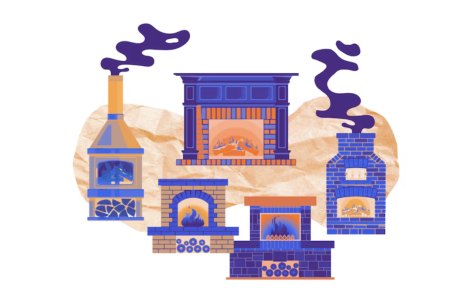
Wood heater sales, along with outdoor pizza ovens and fire pits, rose during COVID. Image source: ABC News.
Amber, in Canberra, fell out with neighbours over wood smoke she said was giving her and her family sinus headaches.
"We were initially really good friends with them … Our whole roof is covered in soot from their chimney."
Several members feared a complaint would lead to their neighbour burning more wood — a practice known in the group as "revenge burning".
Many said complaints to local and state governments had gone nowhere.
These were common stories, Professor Johnston from the Centre for Safe Air said.
"It's a really knotty neighbourhood problem for which we don't have particularly good tools."
Wood smoke pollution was the responsibility of local councils, which were either reluctant to deal with the problem or not resourced to police chimney smoke, she said.
"It really does arouse passions. There's a strong love of wood heaters and a belief in the right to light your own fire."
Wood heater sales (which don't include open fireplaces, fire pits, pizza ovens or other outdoor wood-burners) increased 40 per cent between 2008 and 2021, according to industry group, the Home Heating Association.
Sales dropped after the pandemic, but there's no sign of a long-term decline.
Dr Irga from UTS said cost-of-living pressures and higher electricity prices were driving more Australians to burn wood for heat, including — in some cases — toxic construction materials.
Meanwhile, new air quality monitoring and mapping technologies are making wood smoke harder to ignore.
Keeping track of wood smoke
On July 6, 2025, a combination of cold and calm weekend weather in Melbourne saw wood smoke emissions spike in some areas of the city.The night-time event was captured by a relatively new network of low-cost, real-time air quality monitors, many of them privately owned by households.
Called "Purple Air", the data from these monitors is shared to a publicly accessible online database.
On July 6, around 7:30pm, Purple Air sensors around Melbourne showed levels of particulate pollution considered unhealthy for sensitive groups, even for short-term exposure.
As the night wore on, pollution readings peaked. Heater-owners preparing for bed often close heater vents to stop oxygen flow, leading to incomplete combustion causing wood to smoulder, and produces large amounts of smoke that spreads into the surrounding properties.
The pollution spike was also visible on Google Maps, which introduced an air quality overlay this year based on data from government monitoring stations.
New maps may be helping some groups like My Air Quality Australia keep tabs on pollution, but there's little sign they're changing attitudes more widely.
Surveys show Australians are fairly relaxed about wood smoke, despite having one of the highest asthma rates in the world.
Health bodies such as Asthma Australia and the Australian Medical Assocation want state and territory governments to ban new wood heater installs and phase out the existing ones in residential areas.
But governments appear reluctant to impose such a ban.
On Facebook pages like My Air Quality Australia, there's a mounting sense of outrage.
Even as Australia leads the world in rooftop solar uptake, many rooftops continue to host a much less advanced technology: the smoky chimney.
After the July 6 pollution spike, one user observed that about 10 per cent of the 5 million people who live in Melbourne suffer from asthma, which is aggravated by wood smoke.
"That's 500,000 people and it still feels like no-one cares. How is that even possible?"
Read more: Volunteers uncover shocking truth behind Australia's waterway pollution
Written by James Purtill and Anna Salleh, ABC News.



